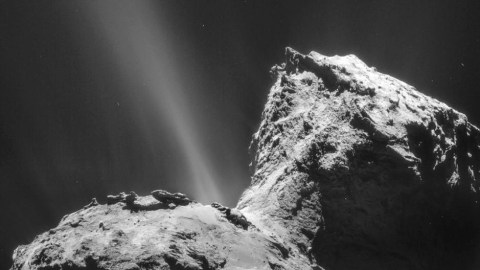Major ingredient for life on Earth formed in deep space, claims new study

Comet 67P/Churyumov-Gerasimenko. Credit ESA/Rosetta/NAVCAM
- Scientists create interstellar icy grains in a super-cold experiment.
- They show that phosphates forms under these conditions.
- Phosphates are crucial building blocks in molecular biology.
Life on Earth would not be possible without a key ingredient that came from an extraterrestrial source, claims new research. Scientists identified that phosphorus, an important component for life, was created in outer space and delivered to Earth by comets or meteorites in the first billion years of the planet’s existence. Once here, phosphorus compounds got incorporated in biomolecules which can be found in the cells of all living creatures on Earth.
Phosphorus, specifically as the derivative phosphates, is essential in the creation of DNA and cell membranes as well as the functioning of other major cellular processes. It’s also necessary for the creation of bone and teeth. Needless to say, it’s a big deal for us, humans. Yet, relative to its importance in biology, it is the least abundant element cosmically.
According to Cosmos Magazine, phosphorus is believed to have formed in supernovas, amid exploding stars. It spread to gas and dust from which new stars and solar systems were condensed. But to become a phosphate, the element had to go through a transformation, which the researchers say likely happened in interstellar dust clouds, courtesy of the chemical phosphine, derived from phosphorus. Tantalizingly, this chemical can also be found in the atmospheres of Jupiter and Saturn, and also in the gas jets from the comet 67P/Churyumov-Gerasimenko – explored in 2014 and 2016 by the Rosetta probe.

Credit: University of Hawaii at Manoa.
To probe the mystery, the researchers could not work with phosphine directly as it’s highly toxic. So they used an ultra-high vacuum chamber that was cooled to 5K (-450°F) and recreated interstellar icy grains. After coating the grains with carbon dioxide, water, and phosphine, and exposing them to ionizing radiation that simulated cosmic rays you’d find in space, the scientists found that various phosphate-like chemicals like phosphoric acid and diphosphoric acid were formed. These chemicals are crucial building blocks in molecular biology.
Thus created in deep space, nanoparticles likely became parts of larger objects – comets or asteroids – which eventually found their way to Earth. Here the phosphates added key ingredients to the primordial cocktail that eventually produced life.
The international research team included the lead author Andrew Turner (graduate student at the time, now assistant professor at the University of Pikeville) and chemistry Professor Ralf Kaiser from the University of Hawaii at Manoa, Cornelia Meinertfrom the University of Nice in France, as well as Agnes Chang of National Dong Hwa University in Taiwan.
“On Earth, phosphine is lethal to living beings,” said Turner. “But in the interstellar medium, an exotic phosphine chemistry can promote rare chemical reaction pathways to initiate the formation of biorelevant molecules such as oxoacids of phosphorus, which eventually might spark the molecular evolution of life as we know it.”
Check out the new study “An Interstellar Synthesis of Phosphorus Oxoacids”, published in the Nature Communications magazine.
Want to see what it’s like to live on the comet 67P/Churyumov-Gerasimenko? Watch this video from the Rosetta probe:





